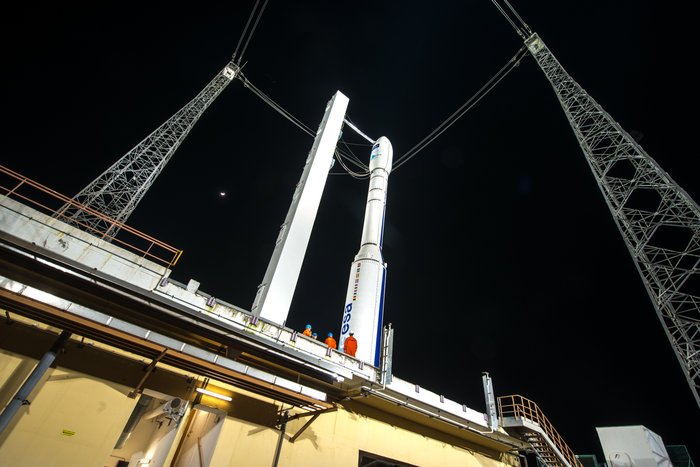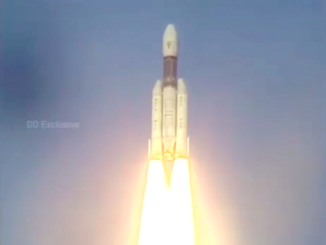
Engineers believe super-hot gas from burning solid propellant impinged on the structure of the second stage on a European Vega launcher during a failed flight in July, causing the vehicle to break apart minutes after liftoff from French Guiana with a reconnaissance satellite for the United Arab Emirates, the CEO of Italian rocket-maker Avio said Monday.
The investigation into the July 10 launch failure, co-chaired by the European Space Agency and Arianespace, settled on the “thermo-structural failure” on the forward dome of the Vega’s Zefiro 23 second stage motor as the most likely cause for the accident, which destroyed the Airbus-built Falcon Eye 1 satellite for the UAE military.
“This is a solid rocket motor, so it’s a carbon fiber cylindrical structure filled with solid propellant that burns at about 3,000 degrees Celsius (5,432 degrees Fahrenheit),” said Giulio Ranzo, CEO of Avio, the lead contractor for the Vega rocket based in Colleferro, Italy.
“Obviously, the burning of the propellant needs to be completely isolated from the structure,” Ranzo said Monday in an interview with Spaceflight Now. “What we believe most likely happened is that some of this heat has unfortunately gone through the forward dome, has reached the forward dome, and caused some type of damage.”
The launch failure was the first for a Vega rocket after 14 consecutive successes.
According to investigators, the first sign of trouble appeared 130.85 seconds after the Vega launcher lifted off July 10, when a “sudden and violent event occurred on the Z23 motor” that led to the break-up of the rocket into two main parts — the Zefiro 23 motor and an upper section comprising the Vega’s Zefiro 9 third stage, liquid-fueled fourth stage, the Falcon Eye 1 satellite and its payload shroud.
“It’s difficult to pinpoint exactly where within the forward dome this may have happened, but the forward dome being the cap — the top cap — of the motor on the opposite side of where the nozzle is, it’s a fairly limited area in the motor,” Ranzo said. “Therefore, there’s likely a limited number of things that we need to go back and check in order to fix it.”
The Falcon Eye 1 mission was insured for 369 million euros, or $407 million, including the value of the satellite and the launch, according to Space News.
According to a press release announcing the results of the failure investigation, engineers ruled unlikely other possible causes of the accident, such as the inadvertent activation of the Zefiro 23’s destruct system. The investigators also “did not find any evidence of a malicious act.”
The Vega launch sequence up to the T+plus 2-minute, 10-second mark occurred as planned, officials said. The rocket’s P80 first stage fired normally until burnout and separation nearly two minutes into the mission, and the Zefiro 23 motor ignited and performed as designed for the first 14 seconds of its 103-second firing.
The rocket’s trajectory started to deviate from its expected trajectory around five seconds after the second stage’s thermo-structural failure, and range safety officials sent a “neutralization,” or flight termination, command to the rocket at T+plus 3 minutes, 33 seconds. Telemetry data from the rocket confirmed it executed the flight termination command.
The final telemetry and tracking signals from the launcher were received by ground stations and radar at T+plus 5 minutes, 14 seconds, as the rocket plummeted into the Atlantic Ocean north of the Guiana Space Center.

The failure investigation board proposed an “exhaustive verification plan of its findings based on analyses and tests.” Engineers will also assess processes, subsystems and equipment in the Zefiro 23 forward dome area.
“In the forward dome, you have this carbon fiber structure, you have the igniter system, and you have some minor subsystems, pressure gauges and stuff like that,” Ranzo said. “So we’ll have to review the assembly process of all of this. We’ll have to review the way we check these subsystems during manufacturing to see if there’s any defect or damage. We’ll need to make all of these processes and equipment assembly more robust than it is.”
The design of the Zefiro 23 motor appears to be “extremely robust,” Ranzo said.
“This is somewhat clear because we have reviewed the performance in flight of all the preceding 14 flights, and we didn’t find in any of those flights any evidence that the structure might be underdesigned or something like that,” he said. “Therefore, we do not envision (any design problems).”
Avio and Arianespace, which operates and markets Vega launch services, plan to resume Vega flights in early 2020, before the end of March.
“At the very beginning of 2020, we’ll start assembly on the launch pad of the first rocket for return-to-flight,” Ranzo said. “Between now and then, we will work with Arianespace to reshuffle the manifest to make sure we can satisfy the expectations of our customers the best we can.”
Since its debut launch in 2012, the Vega rocket has primarily launched Earth observation satellites for ESA, the European Commission and governments outside Europe, such as the UAE, Morocco, Israel, Kazakhstan, Peru and Vietnam.
Before the July 10 failure, the next mission on the Vega launch manifest was a multi-payload rideshare flight with 42 small satellites for commercial and university customers. Ranzo said Monday it was too early to know if the rideshare mission would fly on the next Vega rocket, or if another payload would get the nod.
“In spaceflight, delays are more common than exceptions,” Ranzo said. “Therefore, we will check the status of the customers and try to readjust the schedule in a way that best meets the customer needs. We don’t have the 2020 schedule finalized yet.”
“Avio will now work hard and with extreme confidence on the return-to-flight plan to restore the strong track record of success of the Vega launcher,” Ranzo said. “Learning from failure is an integral part of our mission to provide our customers with improved products and solutions to meet their challenging requirements. We will now, therefore, plan activities and resources for the next few months with the view to satisfy their expectations at best.”
“Along with our industrial partner Avio, we will be doing everything in our power to reconnect with the 14 successful launches already recorded by our light launch vehicle,” said Stephane Israel, Arianespace’s CEO.
In partnership with ESA, Avio is developing an upgraded Vega rocket named the Vega C for an inaugural launch next year. The Vega C will use more powerful solid-fueled motors, replacing the basic Vega’s P80 first stage with a bigger P120 rocket motor, and introducing the larger Zefiro 40 second stage in place of the Zefiro 23.

Arianespace has signed contracts with customers to fill at least nine Vega and Vega C launches, according to previous statements by the company. Some of the satellites booked to fly on future Vega rockets will launch on rideshare missions, and officials have not announced firm payload assignments for many of the flights.
In addition to the firm backlog, ESA and European member states have committed more unspecified government missions to launch on the Vega C in the early 2020s.
One of the Vega launches in Arianespace’s backlog is slated to deliver the UAE’s Falcon Eye 2 satellite to orbit, an identical spacecraft to the payload lost on the failed July 10 mission.
Ranzo said Monday that the Vega C’s first launch is scheduled between April and June 2020. The Vega C, with its uprated second stage motor, should be immune from the problem that caused the launch failure in July, he said.
“We, at the moment, expect no impact because on the Zefiro 40 we have already designed and implemented some upgrades that would overpass all these things that we need to do on Zefiro 23, so we are not particularly concerned,” Ranzo said. “But I think we will have some lessons learned, and if anything, we will do adjustments as needed, but that shouldn’t impact any of the flight items that will be on the Vega C maiden flight.”
Email the author.
Follow Stephen Clark on Twitter: @StephenClark1.



